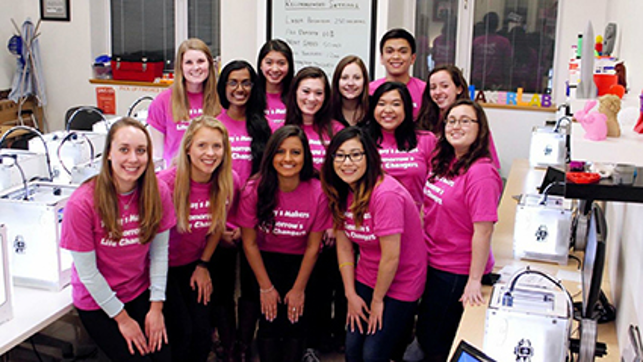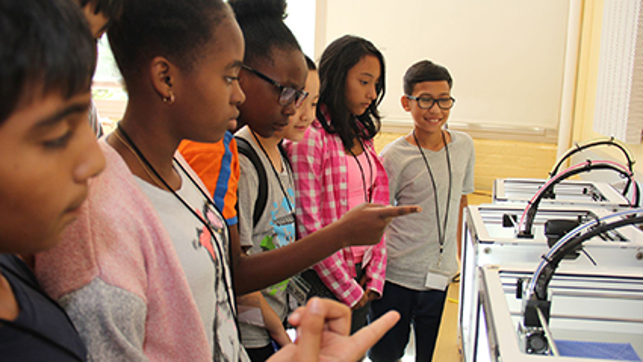Ultimaker has launched its Pioneer Program in the US, which is all about promoting STEM education. Here John Kawola explains why it is so important to give kids access to 3D printing early

Ultimaker in the CrEST (Creativity in Engineering, Science, and Technology) classroom at the NYU Tandon School of Engineering in New York
As 3D printing technology continues to evolve, more and more schools are adopting and integrating 3D printing as an important part of their curriculum, from pre-K (that’s a preschool program for children at or below the age of five, if you’re not in the US) to higher education.
There are three main reasons for this. The first is that 3D printing is quickly becoming part of the toolkit that professionals use in a range of fields.
The more that students use and learn about the tools that are being used in the industry, the more they will be prepared to be effective and contribute to the workplace.
PCs, laptops and tablets are used extensively in all levels of education, even early childhood programs, because these tools are now ubiquitous in all aspects of our personal and professional lives.
For example, in accounting fields, it is assumed that students entering the workforce are proficient with spreadsheets and financial modelling software.
In engineering and design, it is now expected that students are fully proficient using 3D CAD software.
The earlier these common workplace tools are taught in schools, the more ready and proficient our future workforce will be.
The second reason is that 3D printing offers a very unique opportunity to enhance learning by providing full physical representation that is not easy to match in pictures or on a computer screen.
For engineering students, holding a part in their hand provides a level of insight into the viability of their design. For maths students, seeing a physical representation of a mathematical equation enhances learning by connecting the dots between the tool (calculus) and its end purpose.
Medical students can now more easily visualise and practice. Art students can create work that cannot be easily created using other approaches.
The third and final reason, and perhaps the most important, is that 3D printing provides a unique way to enhance creativity — it’s an important part of STEAM (Science, Technology, Engineering, Arts, Mathematics) education.
Children can learn at an early age how to conceive and build things. They can learn how to use software and other tools to turn what is in their heads into tangible objects.
Whether these 3D objects are functional engineered parts, artwork, or game pieces, the new pathway of quickly creating these objects engages students and facilitates the learning process.
While the step change in price has made 3D technology more affordable, there is generally still a relatively large gap in knowledge, lack of suitable content creation software and, perhaps most importantly, lack of rich curriculum and lesson plans available for teachers to use and more effectively deploy 3D printers.

Equipped with 3D printers, laptops, and creative session materials, MakerGirl is a non-profit organisation that aims to expose girls to 3D printing
Compounding this gap is the fact that 3D printers have moved beyond just the engineering and design courses at top universities. 3D printers are used in art classes. 3D printers are used in maths classes. 3D printers are being used in biology and medical education. 3D printers are being used by 25-year old-graduate students. 3D printers are being used by 8-year-old primary school kids.
To help solve this problem, Ultimaker recently launched its Pioneer Program with the intent of providing an easy-to-use and rich library of resources for teachers and students, and to build a community around 3D printing.
We made the choice of opening this program up to educators, regardless of what brand and make of printer they are using, to make it more generally available.
Our hope is that by building a dynamic community that’s passionate about the promise of 3D printing, teachers across the USA will publish and share content that inspires students to learn and create.
An idea generated in a 7th grade science class in Iowa may find its way to a high-level graduate design program in New York.
Contests will emerge across a collective of schools to teach students the power of collaboration and community. The possibilities are limitless and will inspire the next generation in the workforce.
We kicked off the program with 58 inaugural members, all educators who have experience with 3D printing and are beginning to populate the resource with curriculum, part challenges, and content and contest ideas.
Technology vendors (hardware, software and materials) are not the entities that will drive more widespread adoption of 3D printing in classrooms — adoption and acceptance will be driven by the education community itself.
The more that educators use resources like the Pioneer Program, the more they will conceive lesson plans and teaching modules that will match the technology with the intent of education and prepare students for the future.
John Kawola on STEM and Ultimaker’s Pioneer Program
Default






